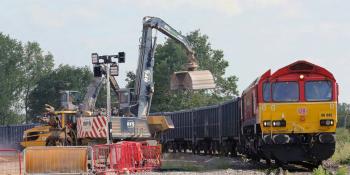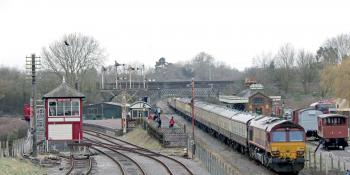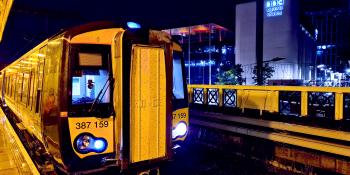Very-Lite now that the Treasury is raiding Network Rail’s asset sales
This column has reported on four Periodic Reviews of Network Rail’s track access charges. In the process, ‘Informed Sources’ faithful readers have suffered thousands of words and seemingly endless pages of tables and graphs as I have tried to explain what was going on and the implications for the railways.
Of course, I would rather have been writing about the workings of the real railway. But I believe that if we don’t understand how the modern railway is specified and financed, the structure makes even less sense. And social media reveals daily that a lot of railway people still don’t understand how our industry works, despite my best efforts.
READER-FRIENDLY
But, thanks to the reclassification of Network Rail as a government body, the current Periodic Review 2018 (PR18) is going to be a lot more reader-friendly. Now that Network Rail is part of the Department for Transport, rather than a quasi-independent company limited by guarantee, ministers and civil servants, not to mention the Treasury, no longer have to deal at arm’s length through the Office of Rail and Road (ORR).
No sirree. This time round, Government can cut out the Regulatory middle man – or rather middle-woman – and tell Network Rail what it’s going to do and how much money it’s going to get to do it.
So goodbye, already, to the Initial Industry Strategic Business Plan (IISBP), which in 2011 laid out the industry’s aspirations in hubristic detail. Ditto, probably, Network Rail’s own Strategic Business Plan (SBP). What form the Regulator’s determination of Network Rail’s income and efficiencies takes is something I must chase up.
ADVICE
What will remain, because it is a legal requirement under the 2005 Railways Act, is the Governments’ (Westminster and the Scottish ministers) publication of their High Level Output Statements and Statements of Funds Available (HLOS and SoFA). Meanwhile, as reported previously, in place of the much-ballyhooed IISBP, Network Rail has produced what is termed ‘Initial Industry Advice’ (IIA).
Perhaps the best indicator of ORR’s diminishing role in PR18 will be the publication, or not, of its reconciliation of the HLOS and SoFA. When Network Rail was notionally independent, ORR took the HLOS and SoFA, compared them with the schemes and costs in the Strategic Business Plan and assessed whether the aspirations in the HLOS could be paid for with the money in the SoFA. With Network Rail part of DfT there is no need for an independent reality check, since DfT is omniscient on infrastructure costs.
Obviously someone needs to check whether costs are efficient. But, in the absence of ORR and its armies of benchmarking consultants, that duty will likely fall, retrospectively, to the National Office for Closing Stable Doors, aka the National Audit Office (NAO).

PRIVATE
AlrXeady we are seeing how PR18 is reflecting the new state railway. At a Network Rail industry trade press briefing on 6 April I asked Chief Executive Mark Carne why DfT had decided not to publish the IIA?
Mr Carne replied that it was important not to raise expectations based on industry aspirations at a time of considerable financial challenge. The IIA needs to be considered ‘more carefully and strategically’, he explained.
Mr Carne has, not surprisingly, been scarred by the experience of battling with the outcome of the last Periodic Review, further exacerbated by the effect of reclassification – which has been ‘a very profound change that changes the whole nature of our relationship with government and our funding’. Managing this new relationship through CP5 has been a ‘tremendous challenge’.

IMMATURE
While Network Rail entered CP5 (2014-19) with a long list of projects, many of them were very immature in terms of development. DfT’s late addition of major schemes to the HLOS meant that the costings for many of these enhancements were at an early stage.
In June 2014, of the £12.5 billion of proposed enhancements in CP5, only around £6 billion, largely Thameslink and Crossrail, were firm. While the cost of the remainder was quoted at £6.5 billion, no one knew the actual figure because Network Rail had not been able to work up the schemes fully by the time of the Regulatory Determination in December 2013.
As a result, the £6.5 billion included allowances for risk, optimism bias and various other contingencies. To avoid this uncertainty distorting the efficiency calculations behind Network Rail’s funding for CP5, ORR excluded these ‘late extras’ from the determination and introduced the Enhancements Cost Adjustments Mechanism (ECAM).
Under ECAM, NR took each of the outstanding schemes to GRIP Stage 3 (option selection) then submitted the costs to ORR for assessment. ORR then determined whether this cost represented efficient spending: if not, NR could be told to do it for less.
At an interview back on 5 June 2014, Alan Price, then ORR’s Director of Railway Planning & Performance, told me that the first ECAM schemes were starting to come through. He emphasised that ECAM was a ‘rolling process’ and that ORR had set March 2015 for the work to be completed. Mr Price added that any scheme that had not been signed off at GRIP Stage 3 by then was likely to struggle for completion in CP5.
In the end, all that effort had been nugatory, despite ORR having to boost staff numbers to cope with the mass of schemes flooding in. Reclassification from 1 September 2014, followed by the review of Network Rail’s enhancements programme by newly-appointed Chairman Sir Peter Hendy in 2015, made ECAM irrelevant.
CREDIT CARD
Reclassification has returned Network Rail to a state railway in terms of funding. Previously the Regulatory Asset Base (RAB) mechanism had allowed the quasi-private company to work with ORR on an emerging cost basis.
This meant that if the final cost of a scheme was higher than forecast, but was still deemed efficient by ORR, the extra cost could be covered through increased borrowing on the financial markets. ORR would then add the final cost of the scheme to the RAB, where it would earn the return needed to pay the interest on the extra borrowing.
Not for nothing was this known as the Network Rail credit card. But reclassification cut up the credit card, making the Treasury Network Rail’s only source of borrowing. Strict borrowing limits removed the headroom provided by the ‘credit card’.
As Mark Carne explains, now, ‘we have to develop schemes properly and only announce them when they are mature. Otherwise, all we do is raise expectations which we then dash in the public’s eyes – which then bring us into disrepute as being less than competent’.
As a result, DfT’s HLOS and SoFA for CP6, to be published by 20 July, will focus on Operations, Maintenance and Renewal (OMR). Those existing enhancement programmes being carried over into CP6 following Sir Peter Hendy’s review should have first call on any spare funding. New enhancement schemes will be introduced only as and when they have been developed fully, provided they represent value for money and then only if funding is available.
TABLE 3: CP5 ELECTRIFICATION – UNREAL EXPECTATIONS

Mark Carne is adamant that Network Rail must not enter CP6 in the way it entered CP5. ‘We must have a better plan and we must be more robust to political changes that occur’ he declared.
Even restricting the HLOS to OMR will involve some hard choices. Informed sources are reporting that minimum renewals budgets for CP6 are approximating to the likely maximum budget available.
BOMBSHELL
If this were not bad enough, on 27 April Network Rail published minutes for the September 2016 Board meeting under the company’s transparency policy. Now even I don’t scan Network Rail’s website daily, but The Times picked up an item in the seven-month-old minutes impressively quickly.
In the ‘CP5 Business Plan update’ section, the minutes recorded that the Treasury is ‘requiring’ that the proceeds from the current asset disposal programme should go towards reducing the national deficit.
Now you may think it suspicious that after not updating the Board Minutes for seven months, only nine days after a General Election was announced Network Rail should decide to catch up. Naturally I couldn’t comment.
HENDY REVIEW
When Sir Peter Hendy’s review of Network Rail’s enhancement programme for Control Period 5 identified cost overruns of around £2.5 billion on the £11.8 billion enhancements budget, it was a case of de merde toi legionnaire (look after yourself, no assistance will be coming from anyone else). To cover the bulk of the shortfall, Network Rail would sell non-core and lower value assets worth £1.8 billion. With two years to go, asset sales have raised £24.2 million so far.
With the Treasury also increasing NR’s government borrowing by £700 million, Sir Peter claimed that the £2.5 billion of new money would allow the ‘vast majority’ of programmes and projects to go ahead for delivery by the end of CP5. Delivery of the remaining schemes would be pushed back into CP6 to keep Network Rail within its Treasury borrowing cap.

GRAB
However, as the September 2016 Board minutes noted, the Treasury’s appropriation of the asset sales receipts implied ‘a realistic prospect of a significant shortfall in funding’, since the sales receipts would no longer be available to fund rail enhancement schemes. And even by railway standards £1.8 billion is indeed significant.
Given this situation, the Board agreed that it was paramount that the company should not make commitments ‘beyond its known financial capacity’.
When I asked on 5 May for the state of play, a wary Network Rail spokesperson told me: ‘We have been working closely with colleagues across Government to assess the assets we had earmarked to sell following the Hendy Review; this process is ongoing’.
Also at the September meeting, the Board agreed to review the scale of an enhancement programme that would be deliverable in the remaining two years of CP5 should the Treasury’s ‘accounting’ treatment make the expected funds unavailable. In parallel, NR would also explore additional loan facilities to deliver the CP5 enhancement programme and the overall business plan.
CUTS
I don’t expect to see any more board minutes published anytime soon, but it can’t have been a coincidence that six weeks after that September board meeting, DfT announced the deferral of four sections of the Great Western Electrification Programme, saving £146-£165 million during the remainder of CP5. More schemes are being deferred or cancelled, including enhancements on the East Coast main line.
INDUSTRY
All this, of course, impacts on the supply industry. When I asked Mark Carne about the effect on contractors of the lack of an enhancements programme in the CP6 HLOS, he replied that in the past ‘we gave them (contractors) false certainty. The sense that there was this endless pipeline of work was a bit of an illusion because it wasn’t mature and the timeframes were wrong’. In future Network Rail intends to have ‘a more transparent funnel of projects we are looking at’, but that are not commitments.
Mr Carne quoted the trans-Pennine upgrade as a case in point. ‘It’s a really important project, but I am not going to tell you what I think it is going to cost and I am not going to tell you how long I think it is going to take to do until we have done the work’.
Development of the TP upgrade is scheduled for completion by December 2017. Funders will then be able to make an informed decision on what they want. Or, I suspect, what they can afford.
Of course, contractors have opened up colleges to train staff to handle the Government’s much-vaunted ‘largest investment in our railways since Victorian times’.
‘What about them?’ I asked Mark Carne. The reply was brutal in its honesty. ‘We don’t plan all of our projects in a way that manages the capacity of the industry’.
While Network Rail would want to ensure continuity of employment wherever possible, Mark Carne added, ‘I would far rather do that on the basis of firm clear commitments that I can stand behind and that I am confident we will deliver than a series of illusions which don’t have substance behind them’.
He believes that ultimately the market will value this approach because contractors will have confidence that a project is going to happen and is ‘something we can commit to’. The phrase ‘once bitten, twice shy’ springs to mind.
MAINTENANCE SPECIFIC
‘CP6 will be primarily an OMR funded element and there will be a series of projects that will get independent funding when it is appropriate to invest in them’. Mark Carne, Chief Executive, Network Rail, 6 April 2017



